Highways in Romania
Controlled-access highways in Romania are dual carriageways, grade separated with controlled-access, designed for high speeds. In 2012, legislation amendments defined two types of highways: motorways (Romanian: Autostrăzi) and expressways (Romanian: Drumuri expres).
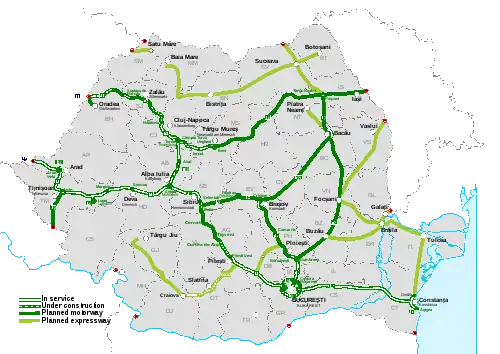
The main differences are that motorways have emergency lanes and the maximum allowed speed limit is 130 km/h (81 mph), while expressways do not and the speed limit is 100–120 km/h (62–75 mph).[1]
The EU accession of the country in 2007 and the improved utilization of the allocated EU funds in recent years, enabled Romania to speed up the expansion of its highway network. There are no toll roads, but a vignette is required, except for municipal roads.
As of 17.12.2020, there are 914.38 km (A 910.82 km / DX 3.56 km) of highways in service.[2]
Only A2 is completed, while A1 is mostly completed with significant sections currently being built. A3 has two large segments that are currently in use, but most of it is still only planned, with only a small part under construction. A10 will likely be the next completed highway, while A4, A6, A7 and A11 currently have only small segments in use. Plans to extend the current network include seven other motorways, but none are likely to be completed in the near future.
Official labels

Motorways are identified by A followed by a number. There are few tolls for using roads in Romania. There is one at the Giurgeni – Vadu Oii Bridge over the river Danube on highway DN2A at Vadu Oii and one at the Cernavodă Bridge, on the A2 motorway, a 17 km long section between Feteşti and Cernavodă which consists of two road/railway bridges. Nevertheless, every owner of a car that uses a motorway (A) or a national road (DN) in Romania must purchase a vignette (rovinietă) from any of the main petrol stations or at any post office throughout the country.[3]
History
Pre-1990
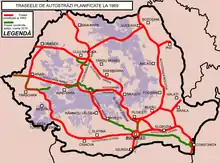
The construction of the first motorway in Romania began in 1967, and the first segment of the A1 motorway, from Pitești to the capital Bucharest was opened in 1972 with a total length of 96 km. During the building of this motorway, a general plan was released in 1969, detailing the building of motorways in the incoming years, however, due to low volumes of traffic, the communist regime focused on improving current roads instead. Until the collapse of the communist regime in 1989, the building of the second motorway between Bucharest and Constanta had been planned, but only an 18 km long segment of A2 from Fetești to Cernavodă, opened in 1987.
Before joining the EU
In the 1990s, the transition from a centralized economy to a market economy severely limited investment into infrastructure projects, and the entire motorway network totaled 113 km for several years until the construction project of A2 was resumed in 1998. Actual construction began in 2001, and three segments were finally opened in 2004 (Bucharest – Fundulea, Fundulea – Lehliu and Lehliu – Drajna) and another in 2007 (Drajna – Fetești) totalling around 130 km. The A1 motorway was extended also in 2007 with the Pitești bypass. A large sector of A3, termed "Transylvania Motorway", was awarded controversially in 2004 without bidding to the American Bechtel Corporation. Large cost overruns and delays ensued for this project, and after political controversies, most of the contracts were cancelled, and only some 50 km of the Cluj bypass (Gilău – Turda – Câmpia Turzii) were opened between 2009 and 2010, at much larger costs than initially signed in the contract.
Following EU integration
| Year | Opened (km) | Total (km) |
|---|---|---|
| 1972 | 96 | 96 |
| 1987 | 18 | 113 |
| 2004 | 97 | 210 |
| 2006 | 37 | 247 |
| 2007 | 14 | 261 |
| 2009 | 42 | 303 |
| 2010 | 27 | 330 |
| 2011 | 71 | 402 |
| 2012 | 128 | 529 |
| 2013 | 119 | 638 |
| 2014 | 51 | 688 |
| 2015 | 48 | 735 |
| 2017 | 15 | 748 |
| 2018 | 59 | 807 |
| 2019 | 43 | 849 |
| 2020 | 65 | 914 |
| 2021 | 0 | 914 |
After joining the European Union in 2007, Romania was able to access funds for infrastructure development more easily, especially for those part of the Pan-European Corridor IV overlapping with A1 and A2 motorways. Many segments of the A1 motorway were started, and by the end of 2011 around 85 km were partially or fully opened: A1 segments Timișoara – Arad and Sibiu bypass; A2 segment Murfatlar – Constanța; A4 Constanța bypass and A11 Arad bypass.[4] By the end of 2012 more segments were opened: the A1 between Deva – Simeria, the A2 between Cernavodă – Murfatlar, another segment of the A4, the Constanța bypass, and the first A3 segment built by a different joint venture than Bechtel, Bucharest – Ploiești. At the end of 2013, more segments of the A1 opened: parts of Lugoj – Deva, Sibiu – Orăștie – Simeria, and the first sector of the A6, between Balinț – Lugoj, and the final segment of the A4 (the Constanța bypass). In 2014 and 2015, more A1 segments were opened between Sibiu – Orăștie, Arad – Nădlac, and Timișoara – Lugoj, for a total of 726.6 km of motorways in use in Romania in December 2015.
Political debates and changes in priorities of left-leaning parties after 2014 greatly slowed down motorway projects.[5] In 2016, there were no new segments opened, with a small segment part of Lugoj – Deva opening in 2017.[6] In 2018, 40% of the A10, between Aiud – Turda, and A3, between Ungheni – Iernut,[7] Gilău – Nădășelu, the entrance into Bucharest opened to traffic,[8] bringing the total to over 800 km. In 2019, two more segments of the A1 opened (between Coşeviţa – Deva), providing an almost fully opened motorway (excluding a segment of 13.5 km) between the border with Hungary and Sibiu. In 2020, more segments were opened, on the A3 (Biharia − Borș, Iernut − Chețani, Râșnov − Cristian), the first segment of the A7 (the Bacău bypass), and a segment on the A10 (Sebeș – Alba Iulia), bringing the total to over 900 km of highway.[9][10]
Current projects
.jpg.webp)
As of August 2020, there are 208.7 km that were awarded for construction and 73.1 km that were also tendered. Several segments are currently being built: the last segment of A10 (24.3 km), the A3 between Cheţani – Câmpia Turzii (15.7 km) and a small segment near Târgu Mureș (4.5 km), and the first segment of the A1, between Sibiu – Pitești. Additional contracts have been signed for construction: the Southern part of the Bucharest Ring Motorway, the second of the five segments of the Piteşti – Sibiu section of the A1, and two additional segments on the A3 motorway (40.8 km), in the north-western part of the country.
Currently the only completed motorway is A2, with A10 likely being the next one to finish in 2021. The unfinished segments of A1 and A3 are in various stages of planning and construction, with several segments likely to finish by 2022–2025. There are no active planned projects for extending the current A4, A6 and A11 motorways that are in usage, as only projected long-term plans are envisioned in various infrastructure masterplans.[11]
A few other motorways have received active discussion, including a termed A0 Bucharest Motorway Ring Road as an outer ring to the Bucharest Ring Road. The A7 motorway, between Ploiești – Siret, has been planned to be part of the Pan-European Corridor IX, but so far only the Bacău bypass (16.2 km) has been built. Beyond Pașcani, the Corridor IX is envisioned to be covered by the A8 (the East–West Motorway, a link between Moldavia and Transylvania). Plans have been brought forward to link Craiova to the A1 through an A12 motorway. Highways crossing the Carpathian Mountains have been delayed due to large costs, with debates on whether to build the A3 (through long-term concession contracts) or the A1 (EU funds would cover most of the cost). The A13 is planned to have two sections between Făgăraș–Sibiu (viewed as an alternative to link the A1 and the A3) and Brașov–Bacău (between Moldavia and southern Transylvania). A9 is planned to link A1 to Serbia, while the A5 is planned to link Bucharest to Bulgaria.[11][12]
Future timeline
Contracted segments with estimated openings:[13]
- 2021:
- A10 motorway, Sebeș - Turda, the lot 2 between Alba Iulia North - Aiud (24.25 km) (Q3)
- A3 motorway, Târgu Mureș - Ogra, the lot 1 between Târgu Mureș - Ungheni (4.5 km) (Q4)
- DX5 expressway Bucharest-Giurgiu, the Giurgiu east bypass (6 km) (Q4)
- DX14 expressway Stânca-Costești-Oar, the Satu Mare bypass (12 km) (Q4)
- 2022:
- DX12 expressway, Craiova - Slatina, the section S1 & S2/lot A-B (entirely 57.55 km)
- A1 motorway, Pitești - Sibiu, the lot 1 between Boița - Sibiu (14.15 km)
- A3 motorway, Ogra - Câmpia Turzii, the lot 3 between Chețani - Câmpia Turzii (15.69 km)
- A3 motorway, Suplacu de Barcău - Borș, section 3C2 between Chiribiș - Biharia (28.55 km)
- A3 motorway, Nădășelu - Suplacu de Barcău, section 3B5 between Nușfalău - Suplacu de Barcău (13.55 km)
- DX8 expressway, Brăila - Jijila and Danube Bridge (1974.3 m, entirely 19.095 km)
- 2023:
- A0 motorway, Bucharest South Ring (47.995 km), section 2 between Vidra - Bragadiru (16.30 km)
- A3 motorway, Nădășelu - Suplacu de Barcău, section 3B2 between Zimbor - Poarta Sălajului (12.24 km)
- A3 motorway, Nădășelu - Suplacu de Barcău, section 3A2 between Nădășelu - Mihăiești (16.80 km)
- A3 motorway, Nădășelu - Suplacu de Barcău, section 3B1 between Mihăiești - Zimbor (13.26 km)
- DX12 expressway, Slatina - Pitești, the sections S3 & S4 (entirely 63.57 km)
- 2025:
- A1 motorway, Pitești - Sibiu, the lot 5 between Pitești - Curtea de Argeș (30.35 km)
- DX6 expressway, Galați - Brăila (11 km)
List
Motorway (A) - Expressway (DX) |
From | Route | To | Planned (km) | In service (km) | |
|---|---|---|---|---|---|---|
| Number | Name | |||||
| Bucharest Ring |
Bucharest | Bucharest | 100.765 | 0 | ||
| Intended to serve as an outer ring to the existing Bucharest Ring Road. First segment awarded for construction was on the southern half in 2018. Currently is partially under construction, with the first openings due in 2022.[16] | ||||||
| Transcarpathian | Bucharest | Bucharest Ring Road – |
Nădlac → |
580.20 | 444.93 | |
| Bucharest–Pitești (109.66 km), Sibiu–Holdea (175.71 km), and Margina-Nădlac (159.56 km) sections are operational. In the project phase is the section of the Holdea-Margina tunnels (13.16 km) and the Pitești-Sibiu section (122.11 km), from which Piteşti – Curtea de Argeş (30 km) and Sibiu – Boița (13 km) are under construction. | ||||||
| Sun | Bucharest | Bucharest Ring Road – |
Constanța | 203.00 | 203.00 | |
| Operational on the entire length since 2012, first fully completed motorway in Romania. | ||||||
| Transilvania | Bucharest | Bucharest Ring Road – |
Borș → |
606.53 | 173.9 | |
| Bucharest–Ploiești (62.79 km), Râșnov-Cristian (6.30 km), Ungheni-Chețani (31.60 km), Câmpia Turzii–Nădășelu (61.25 km), Biharia-Borș II (5.35 km) sectors are operational. Part of the Cristian bypass (3.56 km), although not part of the A3, is built to DX standard. A3 and A13 intersect on the Brașov-Făgăraș segment. A3 status of the Făgăraș–Târgu Mureș segment (108.0 km) remains unclear, and the government wants it at the DX standard (after 2030). | ||||||
| Dobruja | Braila | Tulcea – Ovidiu – |
Vama Veche → |
269.9 (version) | 22.20 | |
| Only Constanța bypass is A and in use. Brăila - Constanța (187.7 km) and Agigea - Vama Veche (60.0 km) sections are DX. | ||||||
| Vlasia | Bucharest | Giurgiu → |
55.2 | 0 | ||
| 6km are under construction in from 2020, which represent also the Giurgiu bypass. Initially A5 was designated Sibiu - Brașov, but this segment was united with Brașov - Bacău, which forms A13. | ||||||
| Wallachia | Lugoj | Bucharest | 488.5 (version) |
11.40 | ||
| Opened only as the Lugoj bypass from the junction with A1.[17] The segment Bucharest - Craiova has 195.0 km, Craiova - Calafat - Dr.Turnu Severin has 151.5 km and the segment Dr.Turnu Severin - Lugoj has 142.0 km. | ||||||
| Moldova | Ploiești | Siret → |
424.70 | 16.269 | ||
| Only Bacău bypass (16.269 km) is in use. The Ploiești - Pașcani section is A, and the Pașcani - Siret section (102.0 km) is DX. | ||||||
| Union | Târgu Mureș | Ungheni → |
311.07 | 0 | ||
| East–West motorway between regions of Transylvania and Moldavia, feasibility studies under revision with estimated construction period 2022–2030. | ||||||
| Banat | Timișoara | Moravița → |
92 | 0 | ||
| Intended to link Timișoara with Serbia's motorway network. | ||||||
| Mihai Viteazu | Sebeș | Turda | 70.00 | 46 | ||
| Aiud–Turda opened in July 2018, Sebeș–Alba Iulia North opened in December 2020, with the segment Alba Iulia–Aiud due to be opened by 2021. | ||||||
| Crișana | Arad | Biharia | 134.628 | 2.0 | ||
| Only junction with A1 is operational since 2011. The A-profile motorway is 58.168 km, having 3x3 lanes on 14.640 km and 2x2 lanes on 43.528 km. The DX-profile highway is 76.460 km.[18][19][20] | ||||||
| Oltenia | Pitești | Craiova | 121.19 | 0 | ||
| Slatina - Craiova (57.5 km) is under construction. All other segments (between Pitești and Slatina, 63.7 km) were awarded for construction in 2020. | ||||||
| Carpathia | Sibiu | Bacău | 289.5 (version) |
0 | ||
| Intended as a link between southern Transylvania and Moldavia. The section Sibiu - Brașov has 129.6 km (version), and the section Brașov - Bacău has 159.9 km (version). | ||||||
| Northern | Stânca-Costești | Oar → |
335 (version) |
0 | ||
| 12km which represents also the Satu Mare bypass are under construction, estimated to the completed in 2021. The A14 and DX15 intersect between Dej and Livada.[21][22][23][24][25][26] | ||||||
(version) |
Someș | Turda | Halmeu → |
264.6 (version) |
0 | |
| The A14 and DX15 intersect between Dej and Livada.[24][14] | ||||||
| DX16 (version) |
Muntenia | Buzău | Galați | 109 (version) |
0 | |
| The Buzău - Brăila segment has 98.0 km, and the Brăila - Galați segment has 11.088 km.[27][14] | ||||||
| DX | Bessarabia | Tișița | Albița → |
160 (version) |
0 | |
| The highway road (DX) will make the connection between Bucharest and Chișinău.[28][29][30][14] | ||||||
Expressways
Planned expressways as of 2020 according to CNADNR (Romanian National Company of Motorways and National Roads):[31]
| Route | Planned (km) | In construction (km) | In Service (km) |
|---|---|---|---|
| A3 – Henri Coandă Airport | 9.0 | 0 | 0 |
| Găiești – Târgoviște – Ploiești | 74.2 | 0 | 0 |
| Craiova – Târgu Jiu | 109 | 0 | 0 |
| Craiova – Calafat | 78.7 | 0 | 0 |
| Drobeta-Turnu Severin – Calafat | 72.8 | 0 | 0 |
| Suceava – Botoșani | 26.0 | 0 | 0 |
| Bacău – Piatra Neamț | 61.0 | 0 | 0 |
| Focșani – Brăila – Galați - Giurgiulești | 97.3 | 0 | 0 |
| Pitești – Câmpulung – Brașov | 124.0 | 0 | 0 |
Gallery
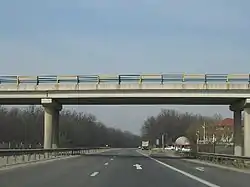 A1 motorway between Bucharest and Pitești, the first Romanian motorway
A1 motorway between Bucharest and Pitești, the first Romanian motorway.jpg.webp) A1 motorway at Pitești bypass
A1 motorway at Pitești bypass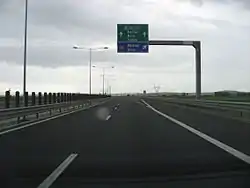 A1 motorway at Sibiu bypass, opened in 2010.
A1 motorway at Sibiu bypass, opened in 2010.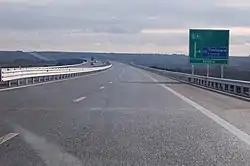 A1 motorway near Timișoara
A1 motorway near Timișoara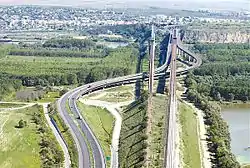 A2 motorway at Cernavoda, opened 1987
A2 motorway at Cernavoda, opened 1987 A2 motorway near Constanta at a junction with the A4 motorway
A2 motorway near Constanta at a junction with the A4 motorway A2 motorway between Bucharest and Fetești
A2 motorway between Bucharest and Fetești.jpg.webp) A3 motorway between Bucharest and Ploiești
A3 motorway between Bucharest and Ploiești
.jpg.webp) A4 motorway (Constanta bypass)
A4 motorway (Constanta bypass) A11 motorway (Arad bypass)
A11 motorway (Arad bypass)
See also
References
- "Ce este un drum expres si cum se aseamana sau se deosebeste de o autostrada" (in Romanian). Hotnews.ro. 30 September 2014.
- "CNAIR: Motorway/Expressway in use (official website of the highway company)" (in Romanian). Cnadnr.ro.
- "Rovinieta 2012 Taxa de Drum si Tarife Rovinieta 2012". Ghidtransport.ro. Retrieved 8 October 2012.
- http://www.zf.ro/eveniment/autostrada-spre-litoral-este-de-20-de-ani-in-constructie-dar-va-fi-finalizata-abia-in-2011-5275732/
- https://www.mediafax.ro/economic/cum-va-arata-harta-autostrazilor-din-romania-strategia-de-dezvoltare-pana-in-2018-proiectul-guvernului-11737538
- "Prezentarea generală a rețelei de drumuri". CNADNR. Archived from the original on 11 February 2010. Retrieved 17 February 2010.
- https://www.wall-street.ro/articol/Auto/237231/cnair-ar-putea-deschide-astazi-circulatia-pe-inca-14-kilometri-din-autostrada-a3-pe-loturile-ogra-iernut-si-ungheni-iernut.html
- https://www.digi24.ro/stiri/economie/transporturi/video-cum-arata-cei-trei-km-de-autostrada-urbana-dati-in-folosinta-dupa-cinci-amanari-1049598
- https://www.economica.net/autostrada-sebe-turda-lotul-1-se-deschide-traficului-dupa-16-30-ministrul-transporturilor_193580.html
- https://www.digi24.ro/stiri/economie/transporturi/s-a-taiat-panglica-pentru-inca-un-ciot-de-autostrada-lotul-de-10-km-dintre-rasnov-si-cristian-a-fost-dat-in-trafic-1419897
- http://www.130km.ro/articol43.html
- http://www.cnadnr.ro/ro/proiecte/autostrazi-pregatire
- http://www.130km.ro/calendar.html
- "ANEXA NR.1 OBIECTIVE DE INVESTIȚII ÎN SECTORUL RUTIER, Proiecte noi de autostrăzi și drumuri expres, Pg.146-147 (2020-2027)" (PDF) (in Romanian). Guvernul României (https://gov.ro). April 2020.
- http://www.automarket.ro/stiri/pe-hartie-totul-este-perfect-lista-autostrazilor-si-drumurilor-expres-pe-73593.html
- https://monitorizari.hotnews.ro/stiri-infrastructura_articole-22417379-autostrada-centura-sud-capitalei-fost-desemnat-cstigatorul-pentru-constructia-unui-lot-17-5.htm
- "Primul lot al Autostrazii Lugoj – Deva, deschis circulatiei in plina noapte, cu o intarziere de noua luni". Hotnews. 23 December 2013.
- "Au început lucrările la Autostrada A11 Arad - Oradea A3-Drumul Expres Arad - Oradea" (in Romanian). Autolatest.ro. 2020-11-01.
- "PARTENERIAT ÎN VEDEREA REALIZĂRII DRUMULUI EXPRES ARAD-ORADEA" (in Romanian). Primăria Oradea (http://www.oradea.ro). 2020-10-14.
- "30% din drumul expres Oradea-Arad, ce leagă două autostrăzi, ar urma să fie gata până la finalul anului 2023" (in Romanian). Digi24.ro. 2020-11-05.
- "Plenul Camerei Deputaţilor a adoptat proiectul de lege pentru aprobarea obiectivului de investiţii Autostrada Nordului cu 211 deputaţi pentru proiect şi unul s-a abţinut" (in Romanian). Agerpres.ro. 2020-10-27.
- "Autostrada Nordului a primit aprobare" (in Romanian). Digi24.ro. 2020-10-27.
- "Flutur vrea ca Autostrada Nordului (A14) să fie inclusă în Master Planul de Transport" (in Romanian). Obiectivdesuceava.ro. 2020-02-16.
- "Someş Expres legătura dintre Autostrada Nordului (A14) şi vestul Europei" (in Romanian). Floteauto.ro. 2020-04-30.
- "Autostrada Nordului: tronsonul urmează să acopere zonele Vama Oar – Satu Mare – Baia Mare – Dej – Bistriţa – Vatra Dornei – Suceava" (in Romanian). Impact.ro. 2020-10-27.
- "Autostrada Nordului este un drum de mare viteză ce leagă nordul Moldovei de rețelele europene de transport rutier, având următorul traseu: Suceava – Bistrița – Dej – Baia Mare – Satu Mare – Vama Oar (335 km)" (in Romanian). 2mnews.ro. 2020-11-02.
- "CNAIR a desemnat câștigătorul contractului de proiectare și execuție Drum Expres Brăila-Galați" (in Romanian). CNAIR.ro (the highway company). 2020-09-23.
- "CNAIR a semnat contractul pentru elaborarea Studiului de Fezabilitate pentru Drumul Expres Tișița - Albița" (in Romanian). CNAIR.ro (the highway company). 2020-07-07.
- "Autostrada Focşani (Tișița) - Albiţa face obiectul unui proiect de lege intrat în dezbaterea Parlamentului, în care a primit denumirea de Basarabia" (in Romanian). Floteauto.ro. 2020-07-07.
- "Drum expres de la Tișița (Focșani) la vama Albița spre Republica Moldova" (in Romanian). Monitorizari.hotnews.ro. 2020-07-07.
- "Expressway Map 2020".
